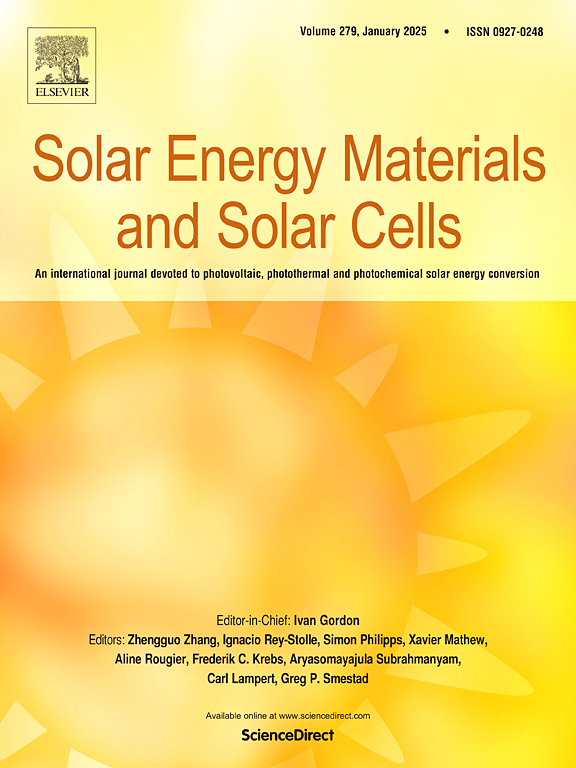Performance prediction of tubular solar air heater with finned semi-Cylindrical absorber and swirl flow using Kolmogorov-Arnold networks and Walrus Optimizer
IF 6.3
2区 材料科学
Q2 ENERGY & FUELS
引用次数: 0
Abstract
In this study, a tubular solar air heater with swirl-flow and find absorber supported by radial and longitudinal fins (SAH) was used to improve thermohydraulic performance. The suggested SAH has been compared to the plain duct SAH without fins at a typical air flow rate of 0.01–0.050 kg/s. The results of this study show that radial fins improve SAH performance characteristics when compared to a plain heater or a heater with longitudinal fins. Furthermore, increasing the number of radial fins and airflow rate improves SAH performance. SAH with five radial fins and an airflow rate of 0.050 kg/s achieves maximum thermal and thermohydraulic performance. The experimental analysis showed that the pressure loss in the proposed SAH with swirl tubes increases by 2.64 % and 16.44 % for AMFR 0.010 kg/s and 0.030 kg/s, respectively. Additionally, radial fins record the highest-pressure loss values, with an increase in pressure loss of almost 11.97 % with maximum average temperature difference about 9.75 °C. Also, this study also demonstrates the effectiveness of various Kolmogorov-Arnold Networks (KAN) models combined with optimization algorithms in predicting the outlet temperature and pressure loss of the investigated heater. The analysis, based on experimental field data, uses five optimization techniques: KAN-CGO (Chaos Game Optimization), KAN-LASHDE (Lagrangian Adaptive Sheepdog Differential Evolution), KAN-AOA (Arithmetic Optimization Algorithm), KAN-HHO (Harris Hawks Optimizer), and KAN-WO (Walrus Optimizer). The KAN-WO model achieved an RMSE of 0.7557, demonstrating that its predictions closely match the experimental data. So, the KAN-WO model emerges as the most reliable for predicting outlet temperature and pressure loss, due to its superior performance, consistency, stability, and ability to generalize.
基于Kolmogorov-Arnold网络和Walrus优化器的带旋流翅片半圆柱形吸收器管式太阳能空气加热器性能预测
本研究采用径向翅片和纵向翅片支撑的旋流式管状太阳能空气加热器(SAH)来提高热水力性能。在典型的空气流速为0.01-0.050 kg/s时,将建议的SAH与无翅片的平原风管SAH进行了比较。本研究结果表明,与普通加热器或带有纵翅片的加热器相比,径向翅片改善了SAH的性能特征。此外,增加径向翅片的数量和气流速率可以改善SAH性能。SAH具有五个径向翅片,气流速率为0.050 kg/s,可实现最大的热和热水力性能。实验分析表明,当AMFR为0.010 kg/s和0.030 kg/s时,带涡流管的SAH压力损失分别增加了2.64%和16.44%。此外,径向翅片的压力损失值最高,压力损失增加了近11.97%,最大平均温差约为9.75℃。此外,本研究还证明了各种Kolmogorov-Arnold网络(KAN)模型结合优化算法在预测所研究加热器出口温度和压力损失方面的有效性。该分析基于实验现场数据,采用了五种优化技术:KAN-CGO(混沌博弈优化)、KAN-LASHDE(拉格朗日自适应牧羊犬差分进化)、KAN-AOA(算术优化算法)、KAN-HHO(哈里斯鹰优化器)和KAN-WO(海象优化器)。KAN-WO模型的RMSE为0.7557,表明其预测结果与实验数据吻合较好。因此,KAN-WO模型由于其优越的性能、一致性、稳定性和推广能力而成为预测出口温度和压力损失最可靠的模型。
本文章由计算机程序翻译,如有差异,请以英文原文为准。
求助全文
约1分钟内获得全文
求助全文
来源期刊

Solar Energy Materials and Solar Cells
工程技术-材料科学:综合
CiteScore
12.60
自引率
11.60%
发文量
513
审稿时长
47 days
期刊介绍:
Solar Energy Materials & Solar Cells is intended as a vehicle for the dissemination of research results on materials science and technology related to photovoltaic, photothermal and photoelectrochemical solar energy conversion. Materials science is taken in the broadest possible sense and encompasses physics, chemistry, optics, materials fabrication and analysis for all types of materials.
 求助内容:
求助内容: 应助结果提醒方式:
应助结果提醒方式:


